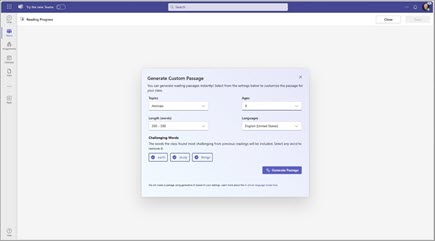Reading Progress can now use AI-generated reading passages to help educators safely create personalized reading assignments for their students. Auto-generated passages can be created from the creation form of a new reading assignment or from the Education Insights Reading Progress report.
Passages generated use guidelines given by the educator, such as the topic of the passage to generate, the student age/reading level, the length of the passage and the required language, as well as words identified for further practice from previous assignments. Generative AI (Azure Open AI) is leveraged to create a new passage where students can practice their reading. Content moderation is employed to generate passages that are safe and meet the students’ reading level.
How does the passage generation technology work?
Passage generation is built on a machine learning model called GPT (Generative Pre-trained Transformer). Trained on a vast number of text samples from the internet, GPT model generates new text that looks and sounds like text that was written by a human, based on the topic, age, length and language selected by the user from a predefined list. It considers the selected practice words and ‘weaves’ them into a passage.

Once generated, educators can choose to update the generated text as they see fit, as well as increase and decrease text complexity using generative AI.
Original content is generated every time, but it is not always factual. To minimize the risk of model-generated inappropriate content, both the input word list and the model-generated response are passed through multiple content moderation filtering steps.
In order to provide content that feels more factual and increase students interest and engagement in the passage, some passages are grounded on Wikipedia content. However, there is no intent and there should not be any user expectation that the content would be fully factual since the passages created and intended as engaging reading material and not learning material.
How should educators use the passage generation?
Educators can use passage generation to quickly create practice opportunities for their students. It is the educator’s responsibility to review and edit the content for appropriateness and accuracy before assigning it to students.
While we employ various filters and safeguards to limit questionable or inappropriate content, the underlying technology of passage generation is AI that has been trained on a wide range of internet sources, so we rely on educators to confirm the appropriateness of the final passage.
What safeguards are employed while generating the passage?
-
Educators are instructed to review and approve the passage before sharing with their students.
-
Passage generation output will be up to approximately 1,000 words.
-
Challenge words presented to the educator to select from are provided based on previous published assignments, all other parameters are taken from pre-defined closed lists.
-
Content moderation is employed on the passage before presented to the educator.
-
Generated passages are only saved as part of the assignment and are not stored in other locations.
Model limitations
-
From the Reading Progress creation form, only up to five challenge words are available to select from, and only when the selected language is English.
-
From the Education Insights report, the passage generation is only available in English, and topic, age, and length can't be chosen. At least one practice word and up to 10 words must be selected to generate a passage.
-
Age-appropriateness evaluation metrics are based on English texts and language statistics of native English speakers. For other languages, evaluation is done on the English version of the passage, which might create a less accurate readability score. Additionally, disparity between native speakers and second language learners should be taken into account.
Data classification for the generated passage
The text generated by the AI is owned by the educator using the functionality. For more information on the use limitations and data access and use terms, see the Microsoft Customer Agreement program under “Azure OpenAI Service."










